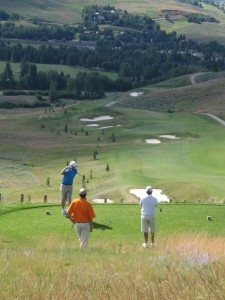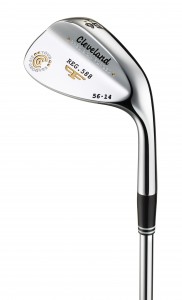I’m playing the cliffside par-3 17th at Half Moon Bay’s Ocean Course. A right-angle wind is roaring in off the Pacific. The hole is 171 yards away, with bad stuff intervening. My thought is to take way more club than necessary, aim at some place like Dutch Harbor, and ride the jet stream back to a green in regulation and a tap in birdie.
Plan.
I need a Plan Two.
From the Sea of Cortez to environs where moose amble across the green, when we tee it up across the great North American West we face a variety of playing conditions. Sure grass is grass and golf is golf. But we have mountains, deserts and seashore, and all can be experienced in a one-day 54-hole golf extravaganza if a player is so motivated.
Following is a bit of a primer of what and how-to. Some is region-specific and some applies to the shortcomings we carry everywhere. It’s all meant to make sure you and your bag are properly loaded, and that has nothing to do with a sixer of Mirror Pond on the pull cart.
The Guy Won Five Open Championships, Trust Him
Tale: I did aim out over the cliff at Half Moon Bay, and I took more club than necessary. The 4-iron parted the air like a 737 and if I had a rope for repelling I could’ve played my next shot from the beach.
Moral: Tom Watson says a well-struck ball is largely unaffected by the wind. Mine was … well struck and unaffected by the wind. This time.
“Growing up playing, I heard that saying a few times from my father’s friends,” says TPC Las Vegas head pro Todd Hajduk of the homily I attributed to Watson but which has over time been pinned to any number of history’s greatest wind players. “They were all pretty good players and now that I have learned about the game, I feel that still holds true.”
Few things rattle recreational players as much as wind. I know it gets to me, and I play a lot of golf in places—Vegas, the coast, the Coachella Valley courses not tucked down in the coves—where wind comes into play. Ironically, the techniques for playing in the wind are ones that would serve us well in most any condition, the foremost of which is swinging under control. Hajduk breaks it down into more discrete pieces, all intended to solidify ball flight by reducing launch angle and both back spin and sidespin:
- Take more club and use a ¾ swing knockdown motion, as when pitching.
- Widen your stance for added stability.
- Tee the ball lower and place it an inch or two farther back in your stance.
- Adjust your alignment, to a degree, to account for the wind direction.
Putting it into more familiar terms, when we overswing into a head or side wind the ball climbs higher and with more sidespin so it falls out of the sky more quickly and into the barranca (ocean, pond, gunch, lumberyard, you name it) with an erratic amount of hook or slice.
Sports are good for pithy sayings, and Hajduk has the perfect one for this situation: “‘When it’s breezy, swing easy.’”
Closing the Gap
Tale: The mean grumpy men who run golf took the fun out of the game after mandating a (phased) removal of Big Bad Square Grooves in most irons and all wedges.
Moral: Many amateurs’ swings wouldn’t allow them to reap full benefit even with grooves the size of expansion joints. However, all the attention on Groovegate hopefully prompted many to get rid of wedges they named “Old Trusty” that were, in fact, simply worn out. If not, there’s another reason to re-tool.
Trying to figure out why you hit that wedge from your new set of irons a kajillion yards, yet you still can’t score? Lofts have been, in the parlance, jacked up, and your turbocharged wedge could be the equivalent of grandpappy’s 7-iron. Toss into the equation that the majority of recreational players’ next, only and last stop on the way to putterland is a standard-issue 56-degree sand wedge and that’s a formula for short-game dysfunction.
If you have 10-15 yards of separation between your higher-lofted irons, and each of those irons is differentiated by three or four degrees of loft, you’re dealing with 40+ yards of no man’s land. Pros can flight shots, add or lessen spin, release the ball or have it zip back. Most of us can’t. Yet by the reckoning of Cleveland Golf, arguably the historic leader in wedges, no one on tour shows up with a two-wedge arsenal and some 25 percent push the number to four.
According to Cleveland’s Scott Carlyle, players should look for an even spacing of four- to six-degrees of loft separation between each wedge, depending on the number of wedges being used, so as to get consistent distance spacing.
As Carlyle reminds, “This is the scoring side of your golf bag.”
Your 15th Club
Tale: The Ryder Cuppers had nothing on me when I played Sonoma Golf Club a few Decembers back. My wife met me for post-golf lunch, took one look, laughed and said, “Ohhhh, I think I’ll keep him.” She has a soft spot in her heart for cold wet puppies that show up come meal time.
Moral: Buy real rain gear, and make it the entire ensemble.
“I am amazed at how many golfers do not have rain gear. It sounds silly but I see them out there with cotton pants, a sweatshirt and maybe a baseball hat,” says Ben Alexander, who in his capacity as proprietor of the Ben Alexander Golf Academy at Poppy Hills in Pebble Beach has ample opportunity to see the vicissitudes of coastal weather. “If you are going to play the game of golf with any weather variability, you need GORE-TEX in your bag. It is like having driver in your bag. It is part of your equipment.”
In my defense, I had rain pants. Crappy ones, it turns out. And while I don’t play with a glove it didn’t really matter because I’d not have had rain gloves in the bag, anyway, or a wide-brimmed waterproof hat so perhaps my glasses actually would have helped my vision. The windshirt offered nothing; there was no wind in the downpour. Now my waterproof Etonics worked wonders, until water started sheet-flowing off the aforementioned less-than-quality rain pants. Umbrella? Left it behind when I moved from Oregon back to California 20-plus years ago.
You need it all.
“I see it day in and day out at Poppy,” Alexander shares. “These guys get cold, they get wet, they stiffen up and don’t play well, and they aren’t happy. They spend thousands on golf equipment but they don’t realize that this gear is part of your equipment.”

An aerie of a tee box and altitude like here at Sun Valley's White Clouds course can -- can, not will -- let a guy really air it out.
A Higher State of Being … For Some
Tale: 523-yard par-4—yes, par 4—8th hole at Sun Valley’s White Clouds course. I hit driver off the cliff, wedge for a green in regulation. No lie. I four putted.
Moral: While you might think the maxim here is that nothing overcomes a lax short game—and that is a fundamental truth—don’t assume everyone will become Bubba Watson when the altimeter starts spinning clockwise and the floor drops out of the elevator.
“Do you add 8 percent, 10 percent, 12 percent, none when playing at altitude? The answer is yes.” So says Jeff Petersen, director of golf at Sun Valley Resort. “Unfortunately, like everything in golf it is not that easy and there is not a ‘golden rule’ or ‘magic formula.’”
Wind resistance decreases at altitude so the ball can fly farther. But spin also drops so it’s a bit like NASA needing to balance a bunch of variables to get those rockets in the air. Thankfully it’s less convoluted in golf. If you want to maximize yardage, increase launch conditions and hang time (the same holds true playing downwind). So if you are really into this stuff try 3-wood off the tee or a higher-lofted driver, and a different ball. You also need to be able to hit the ball on the screws, or what would be the screws if we still used persimmon drivers with face inserts.
“For an average player, do not count on seeing huge differences,” intones Petersen in a bring-‘em-back-to-earth caveat. “You can expect the ball to go a little farther, but do not count on 300-yard drives. For someone who hits the ball solidly and with a higher trajectory they will see a larger increase in distance. The better the ball striker, the larger the distance gain will be.”
Something else to note when on high is optical illusions.
Fairmont Banff Springs pro Steve Young says players often underestimate distances and over-read greens. And he thinks it has to do with more than the trickery built into Stanley Thompson’s magical design: “The mountains and cliffs in the background, this ‘moving’ topography seems to suggest more is happening than really is.”
Oh, great, more junk for us to add to our cluttered swing thoughts.
Having a Ball
Tale: “A golf ball is a golf ball is a golf ball.” How many times have you heard that from someone reaching into the bag and pulling out an algae-stained orb? Then there’s the guy who can’t hit it out of his shadow yet insists on using the model of ball that only a handful of staff players can even use.
Moral: No area of equipment exceeds golf balls for recent evolutionary leaps and bounds. The key is sorting through all the chatter; if you read the boxes, every ball is light-years long with more grip than a politician at a fundraiser.
“The simplest way we can break it down is what your clubhead speed is and how much spin you are looking for around the greens,” says John Rae, a research group manager with Srixon. That sounds easy enough, and it really is. If you can’t do an assessment on a launch monitor—Bridgestone’s traveling fitting van, for instance—grab a sleeve of each ball from a particular manufacturer’s lineup and go out and chip, pitch and putt. Isolate the models that are, in Rae’s words, “Right for how you play your short game and feels good off the putter. Then move back from the green and find the ball you can keep in play.” If this sounds like fun, do the same with other lines of golf balls.
The key is finding where the two intersecting lines cross in a matrix of ball speed and launch conditions (angle and spin), which in the simplest terms equals distance and performance when properly correlated. So-called tour balls—in Srixon’s case the Z-Star and Z-Star Xv—can work for higher-handicap players if they generate enough clubhead speed, which in broad terms means the higher 90-mph range (with driver) for the former and 105+ mph for the Xv. If you swing in the 80s like most recreational players you will not get maximum yield out of the tour balls, and though they are the longest balls in the lineup, they’ll play shorter for you than swing-appropriate offerings elsewhere in the lineup, like the Trispeed or AD333.
Remember the days when the Rock-Flite was touted as the longest thing you could get your hands on? Of course you couldn’t stop it even if the green was made of marshmallow fluff.
The guys in the lab coats are in charge now.
Panaceas are for Other Games
Tale: In the immortal words of The Monkees, I’m a believer, to the tune of having had in my possession hybrids from four or five manufacturers, one of those twice and another thrice, in numbers ranging from a single unit to replace a 3-iron to a complement of four at one time. Michael Vick makes bad decisions with less regimented frequency than hybrids came and went—note the past tense—from my bag.
Moral: These marvels do not turn you into Martin Kaymer simply because you removed the cellophane from the clubhead.
Though not quite the Swiss Army Knife of clubs the PR dudes would have you believe, hybrids are versatile—chipping, shots from fairway bunkers and tight lies, the more typical stand-in for long irons—and a good amount of that versatility comes in the form of ease of use. But while a new putter can lead to instantaneous success, and avowals of lifelong fealty, unlike the car variant, hybrid clubs don’t just turn over at the twist of a key and purr happily and automatically down the figurative road.
“People think hybrids are some kind of magical club,” Alexander advises. “They’re not. They are irons. It might look different but that 3-hybrid or 4-hybrid is a 3-iron or a 4-iron.”
And therein resides the problem.
Your hybrid is not a driver. It’s not a fairway wood. It’s not warp-cored, made of Kryptonite or that one last missing link that will turn you into a tour player. It’s something you need to get down there and dig the ball out of the dirt with. Or as Paul Bucy, head of the Palm Desert Golf Academy at Desert Willow, says, “Swing it like an 8-iron,” even if it’s meant to go 195 yards. (Note he said “swing”; we don’t hit our golf clubs. We swing our golf clubs. Now please repeat after me: “We don’t hit our golf clubs, we swing our golf clubs.”)
Ever the down-to-earth realist, Alexander sums it up best: “It is an iron. I almost wish they hadn’t called it a hybrid.”
I was in Hawai’i not too long ago. 118 yards, slightly uphill, into a Kona wind. Logic dictated more stick, so I hit 9-iron instead of gap wedge.
Tom Watson was correct.
I have a double-bogey to prove it.


